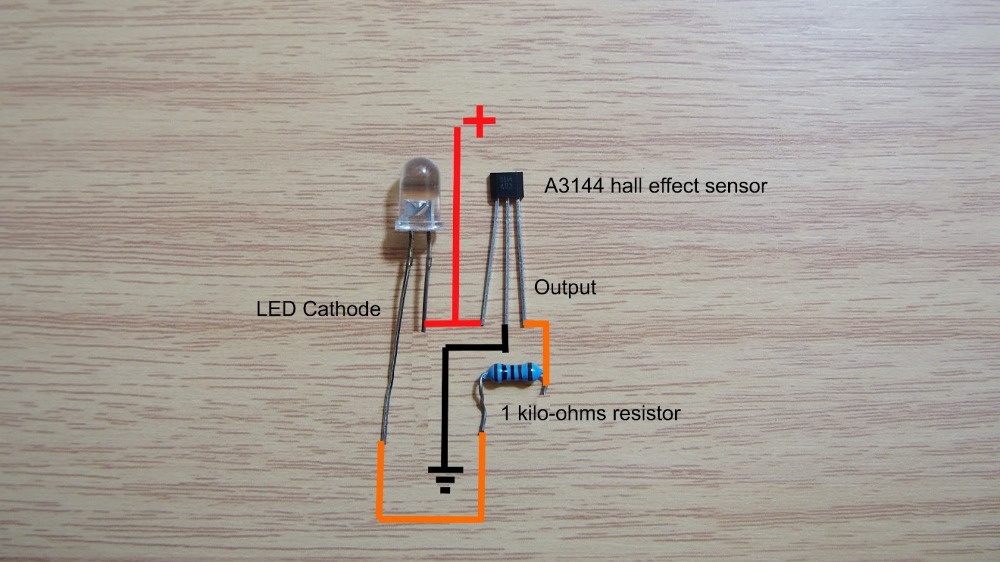Help us help you. By posting the year, make, model and engine near the beginning of your help request, followed by the symptoms (no start, high idle, misfire etc.) Along with any prevalent Diagnostic Trouble Codes, aka DTCs, other forum members will be able to help you get to a solution more quickly and easily!
Hall Effect Sensor Circuit Design Question
- graywave
-
 Topic Author
Topic Author
- Offline
- Elite Member
-

- Adv. Diagnostics New Hampshire
Less
More
- Posts: 302
- Thank you received: 80
7 years 4 months ago #23159
by graywave
Confirm what it's not, and fix what it is!
Hall Effect Sensor Circuit Design Question was created by graywave
Ive had a question for some time that I cant seem to find an answer for. I have a theory but thats it.
Example 96 Jeep 4.0l with a 3 wire hall effect crank sensor. Pull Down design circuit. PCM sends 5v down the signal wire and the crank sensor grounds the signal to produce a square wave pattern.
Question, what is the standalone 5v REF wire used for if the sensor only uses the 5v on the signal and grounds the signal to ground when required?
I can only think that the standalone 5v REF wire (Not signal wire) is used for some sort of signal integrity tests by the pcm.
Same question goes for pull up circuit designs except it would be the standalone ground wire that I would question.
Maybe one of you can fill in this gap I have in my knowledge.
Thanks!
Example 96 Jeep 4.0l with a 3 wire hall effect crank sensor. Pull Down design circuit. PCM sends 5v down the signal wire and the crank sensor grounds the signal to produce a square wave pattern.
Question, what is the standalone 5v REF wire used for if the sensor only uses the 5v on the signal and grounds the signal to ground when required?
I can only think that the standalone 5v REF wire (Not signal wire) is used for some sort of signal integrity tests by the pcm.
Same question goes for pull up circuit designs except it would be the standalone ground wire that I would question.
Maybe one of you can fill in this gap I have in my knowledge.
Thanks!
Confirm what it's not, and fix what it is!
Please Log in or Create an account to join the conversation.
- Ben
-
- Offline
- Platinum Member
-

Less
More
- Posts: 1097
- Thank you received: 215
7 years 4 months ago #23167
by Ben
Replied by Ben on topic Re:Hall Effect Sensor Circuit Design Question
The 5v ref is supplied from pcm and should maintain constant5v. the signal wire will return the 5v to the pcm till pulled down (vice versa for pull up sensor) so with no 5vref nothing happens on the signal wire
Sent from my SM-N920P using Tapatalk
Sent from my SM-N920P using Tapatalk
Please Log in or Create an account to join the conversation.
- Ben
-
- Offline
- Platinum Member
-

Less
More
- Posts: 1097
- Thank you received: 215
7 years 4 months ago #23168
by Ben
Replied by Ben on topic Re:Hall Effect Sensor Circuit Design Question
Hmm I see i didn't actually answer your question lol hang on I'll see if I can find the reference material (if Tyler doesn't beat me to it)
Sent from my SM-N920P using Tapatalk
Sent from my SM-N920P using Tapatalk
Please Log in or Create an account to join the conversation.
- WillRogers
-
- Offline
- New Member
-

Less
More
- Posts: 2
- Thank you received: 1
7 years 4 months ago - 7 years 4 months ago #23169
by WillRogers
Replied by WillRogers on topic Re:Hall Effect Sensor Circuit Design Question
3-wire Hall effect sensors need a constant 5-12 volt power feed from PCM, a 5-12 volt reference from the PCM (pull down design), and a ground.
Ben, the signal wire will also have constant voltage coming from the PCM (pull down design) and the sensor pulls it down to ground. You can identify pull down or pull up by disconnecting the sensor and checking for the presence or absence of voltage on the signal wire (assuming PCM and wiring is good).
Ben, the signal wire will also have constant voltage coming from the PCM (pull down design) and the sensor pulls it down to ground. You can identify pull down or pull up by disconnecting the sensor and checking for the presence or absence of voltage on the signal wire (assuming PCM and wiring is good).
Last edit: 7 years 4 months ago by WillRogers.
Please Log in or Create an account to join the conversation.
- Ash03
-
- Offline
- Premium Member
-

Less
More
- Posts: 147
- Thank you received: 6
7 years 4 months ago #23170
by Ash03
Replied by Ash03 on topic Re:Hall Effect Sensor Circuit Design Question
Thanks for the explanation willrogers!
I have seen a constant voltage on a signal wire (on a vw polo cam sensor) and thought it was shorted to + until i saw it pull down to zero lol.
Sent from my SM-J500F using Tapatalk
I have seen a constant voltage on a signal wire (on a vw polo cam sensor) and thought it was shorted to + until i saw it pull down to zero lol.
Sent from my SM-J500F using Tapatalk
Please Log in or Create an account to join the conversation.
- graywave
-
 Topic Author
Topic Author
- Offline
- Elite Member
-

- Adv. Diagnostics New Hampshire
Less
More
- Posts: 302
- Thank you received: 80
7 years 4 months ago #23173
by graywave
Confirm what it's not, and fix what it is!
Replied by graywave on topic Re:Hall Effect Sensor Circuit Design Question
Thanks for the replies! Ya the jeep example has 5v supply from the pcm on the signal wire and 5v ref and sensor ground from the pcm as well.
Here is food for thought, cutting the signal wire on a 96 jeep 4.0 but leaving the 5v ref and sensor ground supplied to the sensor, then cranking the engine, you will not see any activity on the sensor on its signal wire from the sensor. Atleast not on the 20v scale i was on. Maybe on a 500mv scale i would. I think ill do some continuity tests with a spare crank sensor i have. After noticing i had no 5v square wave that is where my question came from. Thinking the 5v ref wire is only for integrity test. I dont believe it needs 5v power supply to be able to physically switch on and off.
So why would the sensor need a 5v power supply since hall effect sensors are simply a magnetic switch right?
What really confused me before is, i believe on some older chrysler or GMs the pcm supplies a sensor ground, 5v ref and 8v signal ref. Pull down design, Produces 8v square waves. So then, whats the 5v ref for.
Here is food for thought, cutting the signal wire on a 96 jeep 4.0 but leaving the 5v ref and sensor ground supplied to the sensor, then cranking the engine, you will not see any activity on the sensor on its signal wire from the sensor. Atleast not on the 20v scale i was on. Maybe on a 500mv scale i would. I think ill do some continuity tests with a spare crank sensor i have. After noticing i had no 5v square wave that is where my question came from. Thinking the 5v ref wire is only for integrity test. I dont believe it needs 5v power supply to be able to physically switch on and off.
So why would the sensor need a 5v power supply since hall effect sensors are simply a magnetic switch right?
What really confused me before is, i believe on some older chrysler or GMs the pcm supplies a sensor ground, 5v ref and 8v signal ref. Pull down design, Produces 8v square waves. So then, whats the 5v ref for.
Confirm what it's not, and fix what it is!
Please Log in or Create an account to join the conversation.
- graywave
-
 Topic Author
Topic Author
- Offline
- Elite Member
-

- Adv. Diagnostics New Hampshire
Less
More
- Posts: 302
- Thank you received: 80
7 years 4 months ago - 7 years 4 months ago #23174
by graywave
Confirm what it's not, and fix what it is!
Replied by graywave on topic Re:Hall Effect Sensor Circuit Design Question
So i found an article that goes into detail about hall effect sensors. They talk about the Hall effect sensing circuit and how it responds to magnetism which requires a power and ground source to function but since there is a magnet in our sensors it must move away and toward the sensing circuit. I had always thought it was just a simple switch internally.
www.electronics-tutorials.ws/electromagnetism/hall-effect.html
www.electronics-tutorials.ws/electromagnetism/hall-effect.html
Confirm what it's not, and fix what it is!
Last edit: 7 years 4 months ago by graywave.
Please Log in or Create an account to join the conversation.
- graywave
-
 Topic Author
Topic Author
- Offline
- Elite Member
-

- Adv. Diagnostics New Hampshire
Less
More
- Posts: 302
- Thank you received: 80
7 years 4 months ago - 7 years 4 months ago #23175
by graywave
I guess i could have done research before but that article basically fills in the gap in my knowledge.
Confirm what it's not, and fix what it is!
Replied by graywave on topic Re:Hall Effect Sensor Circuit Design Question
I guess i could have done research before but that article basically fills in the gap in my knowledge.
Confirm what it's not, and fix what it is!
Last edit: 7 years 4 months ago by graywave.
Please Log in or Create an account to join the conversation.
- juergen.scholl
-

- Offline
- Platinum Member
-

- Active partschanger
Less
More
- Posts: 1230
- Thank you received: 462
7 years 4 months ago #23218
by juergen.scholl
An expert is someone who knows each time more on each time less, until he finally knows absolutely everything about absolutely nothing.
Replied by juergen.scholl on topic Re:Hall Effect Sensor Circuit Design Question
graywave,
this is a very good and complex analysis of hall effect sensors :
Have a look at part 5 as well.
this is a very good and complex analysis of hall effect sensors :
Have a look at part 5 as well.
An expert is someone who knows each time more on each time less, until he finally knows absolutely everything about absolutely nothing.
The following user(s) said Thank You: Noah
Please Log in or Create an account to join the conversation.
- graywave
-
 Topic Author
Topic Author
- Offline
- Elite Member
-

- Adv. Diagnostics New Hampshire
Less
More
- Posts: 302
- Thank you received: 80
7 years 4 months ago #23226
by graywave
Confirm what it's not, and fix what it is!
Replied by graywave on topic Re:Hall Effect Sensor Circuit Design Question
Thanks bud.
The science behind the hall effect is what I needed, Thank you! Completely polishes off my knowledge on these types of sensors.
The science behind the hall effect is what I needed, Thank you! Completely polishes off my knowledge on these types of sensors.
Confirm what it's not, and fix what it is!
Please Log in or Create an account to join the conversation.
Time to create page: 0.408 seconds


